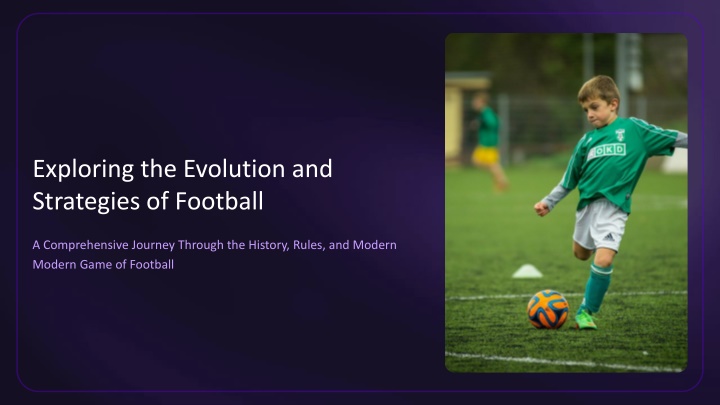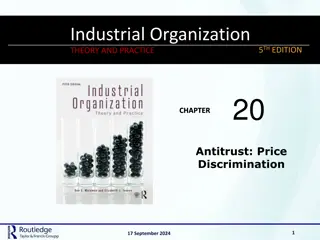Gender Discrimination: Legal Insights & Aims
Learn about gender discrimination from a legal perspective in Irish Employment Equality Law. Explore the aims of Gender Equality Law and the grounds of discrimination under the law. Understand the specific acts that protect employees and the definition of gender discrimination in the workplace. Gain valuable knowledge on equality legislation, case law, and gender-related protections in employment.
Download Presentation

Please find below an Image/Link to download the presentation.
The content on the website is provided AS IS for your information and personal use only. It may not be sold, licensed, or shared on other websites without obtaining consent from the author.If you encounter any issues during the download, it is possible that the publisher has removed the file from their server.
You are allowed to download the files provided on this website for personal or commercial use, subject to the condition that they are used lawfully. All files are the property of their respective owners.
The content on the website is provided AS IS for your information and personal use only. It may not be sold, licensed, or shared on other websites without obtaining consent from the author.
E N D
Presentation Transcript
Exploring the Evolution and Strategies of Football A Comprehensive Journey Through the History, Rules, and Modern Modern Game of Football
Table of contents Lesson Introduction 01 Subject Knowledge: History of Football 02 Subject Knowledge: Rules of Football 03 Subject Knowledge: Strategies of Football 04 Engaging Activities for Students 05 Interactive Discussions 06 Hands-on Experiences 07 Evolution of Football 08 Establishment of Football Clubs 09 Modern Game of Football 10
Lesson Introduction Football History Football has a rich and fascinating history, dating back to ancient civilizations. The modern game as we know it today emerged in the 19th century, with the establishment of the first official rules and the formation of the world's first football clubs. Understanding the evolution of the sport provides valuable context and appreciation for the game. Exploring the Evolution and Strategies of Football
Subject Knowledge: History of Football 01 02 03 04 05 Ancient Origins 19th Century Evolution First Football Clubs International Growth Global Phenomenon The modern version of football began to take shape in the 19th century, with the codification of rules and the establishment of organized competitions. The formation of the world's first football clubs, such as Sheffield FC in 1857, marked a significant milestone in the sport's history. Football's popularity spread rapidly across continents, leading to the formation of international competitions like the FIFA World Cup. Football traces its roots back to ancient civilizations, with early forms of the game being played in various cultures. Today, football stands as the world's most popular sport, captivating audiences with its blend of skill, teamwork, and passion. Exploring the Evolution and Strategies of Football
Subject Knowledge: Rules of Football Field of Play Players Objective The primary objective of football is to score goals by getting the ball into the opposing team's goal. A football field is rectangular in shape, with goalposts at each end. A football match is played between two teams, each consisting of 11 players, including one goalkeeper. The team with the most goals at the end of the match wins. The standard dimensions of a football field are approximately 100-110 meters in length and 64-75 meters in width. Players are not allowed to use their hands or arms to play the ball, except for the goalkeeper within the penalty area. Offside Rule Duration of the Game A standard football match consists of two halves, each lasting 45 minutes, with a 15-minute halftime break. The offside rule is a crucial aspect of football, designed to prevent players from gaining an unfair advantage by being in an offside position when the ball is played to them. In case of a tie, some matches may go into extra time or a penalty shootout to determine the winner. Exploring the Evolution and Strategies of Football
Subject Knowledge: Strategies of Football 01 02 03 04 The first official rules and the formation of the world's first football clubs were established during this time. The first official rules and the formation of the world's first football clubs were established during this time. Football has a rich and fascinating history, dating back to ancient civilizations. The modern game as we know it today emerged in the 19th century. Exploring the Evolution and Strategies of Football
Engaging Activities for Students S W O T Opportunities Threats Strengths Weaknesses Interactive Football Drills: Engage students in practical sessions to enhance their skills and understanding of the game. Limited Access to Football Equipment: Ensure all students have equal opportunities to participate by providing necessary gear. Guest Speaker Sessions: Invite professional players or coaches to share their experiences and insights with the students. Weather Constraints: Plan indoor alternatives or backup activities in case of unfavorable weather conditions. Football Trivia Quizzes: Test students' knowledge of football history, rules, and famous players in a fun and competitive way. Lack of Diversity in Football Representation: Introduce students to a variety of football cultures and players to broaden their perspectives. Field Trip to a Football Stadium: Organize a visit to a local stadium for a firsthand experience of the game's atmosphere and history. Student Disinterest: Tailor activities to cater to different learning styles and interests to keep all students engaged and motivated. Exploring the Evolution and Strategies of Football
Interactive Discussions 01 02 03 04 05 Exploring Football Tactics Match Analysis Interactive Quiz Debates on Controversial Calls Player Roles and Responsibilities Encourage students to watch and analyze a recent football match together. Engage students in a discussion about various football strategies such as formations, pressing, and counter- attacks. Facilitate a dialogue on the different positions on the field and the specific roles each player fulfills. Organize a fun and educational quiz session where students can test their knowledge of football history, rules, and famous players. Prompt students to engage in debates about controversial referee decisions or rule interpretations in football matches. Lead a discussion on key moments, player performances, and strategic decisions made by the teams. Encourage them to present arguments, listen to different perspectives, and develop critical thinking skills. Encourage students to discuss the importance of teamwork and communication in executing successful plays. Encourage them to analyze real-game scenarios and propose their own tactical solutions. Encourage friendly competition and active participation to reinforce learning. Foster critical thinking and observation skills. Exploring the Evolution and Strategies of Football
Hands-on Experiences 01 02 03 04 Engage students in practical sessions to learn fundamental skills like dribbling, passing, and shooting. Analyze recorded football matches to understand tactics, player positioning, and strategic decision-making. Experience the role of a referee by officiating small-sided games, learning about rules and fair play. Experience the role of a referee by officiating small-sided games, learning about rules and fair play. Exploring the Evolution and Strategies of Football
Evolution of Football Ancient Origins 19th Century Emergence Football has a rich and fascinating history, dating back to ancient civilizations. The modern game as we know it today emerged in the 19th century. Formation of Rules and Clubs Context and Appreciation The first official rules were established, and the world's first football clubs were formed during this time. Understanding the evolution of the sport provides valuable context and appreciation for the game. Exploring the Evolution and Strategies of Football
Establishment of Football Clubs Formation of the First Football Clubs Global Impact The first official football clubs were established in the 19th century. The establishment of football clubs globally has contributed to the widespread popularity and growth of the sport. The formation of these clubs marked the beginning of organized football competitions. Clubs serve as hubs for talent development, fan engagement, and community involvement. Role in Shaping the Modern Game These early clubs played a crucial role in shaping the rules and structure of the game. They laid the foundation for the development of football as we know it today. Evolution of Club Competitions Over time, football clubs evolved from local teams to national and international powerhouses. Club competitions such as leagues and tournaments became integral to the football landscape. Exploring the Evolution and Strategies of Football
Modern Game of Football 01 02 03 04 The modern game incorporates technology for VAR (Video Assistant Referee) to ensure fair play and accurate decision-making. Football has become a global phenomenon, with players from diverse backgrounds showcasing their skills in top leagues worldwide. Football has become a global phenomenon, with players from diverse backgrounds showcasing their skills in top leagues worldwide. Over the years, football tactics have evolved significantly, from traditional formations like 2-3-5 to modern systems such as 4-3-3 and 4-2-3-1. Coaches now focus on possession- based play, high pressing, and tactical flexibility to outsmart opponents. The sport's popularity transcends borders, uniting fans and players from different cultures and nations. The sport's popularity transcends borders, uniting fans and players from different cultures and nations. Goal-line technology has also been introduced to determine if the ball has crossed the goal line. Exploring the Evolution and Strategies of Football























